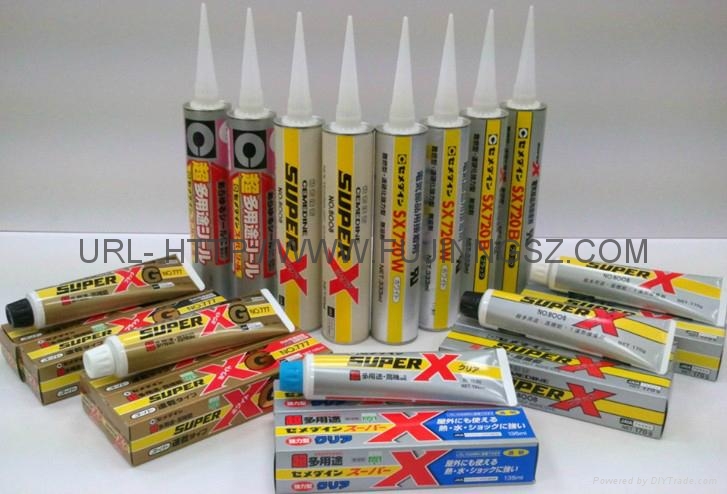Elastomer Adhesive (rubber adhesive)
Elastomer adhesive is composed of main components of such high polymer Elastomer as Chloroprene, nitrile rubber and SBR, and has an excellent initial startup since curing is provided by evaporation of organic solvent and water.
Features
Various types of adhesion
1. Contact adhesion
Adhesive is applied on both sides of the materials, which are put together after an open time of 5 to 30 minutes when the surface is dried up. This will provide adhesion featuring excellent initial strength without the need for temporary fixation.
2. Pressure-sensitive adhesion
Extensive pressure-sensitive adhesion area in the curing process will allow wide-area adhesion of foams and sheets by coating on one side, depending on the conditions.
3. Reactivated adhesion
Elastomer adhesive permits adhesion of the materials after the adhesive coated thereon is dried up and adhesive is reactivated by solvent and heat (about 100°C).
4. Heating and pressurized adhesion
Adhesion of the materials in the same way as heat reactivated adhesion followed up immediately by heat pressing will provide adhesion featuring excellent adhesive strength and heat resistance.
Diversity in coating
1. Brush, spatula and special trowel
2. Air spray, air-less spray
3. Roll coater and curtain coater
Three big features of nitrile rubber
1. Excellent oil resistance
2. Superb adhesive property on plasticized polyvinylchloride
3. Good heat aging
Application
| • Adhesion between rubber and metal
|
• Adhesion of foams such as foamed urethane and polyethylene (except for styrene)
|
| • Adhesion of Glass wool and rock wool
|
• Adhesion of boards and metallic plate
|
| • Adhesion of decorated panel and plywood
|
• Adhesion of soft polyvinylchloride product (only for nitrile rubber)
|
Chloroprene Rubber Cemedine 575
• Adhesive strength
| Time to leave test piece (days)
|
1
|
3
|
5
|
10
|
New method
|
| Adherend
|
| Between vulcanized rubber and steel plate
|
2.7
|
2.5
|
3.3
|
2.8
|
Peeling strength (N/mm)
|
| Between vulcanized rubber and melamine coated surface
|
2.2
|
2.9
|
2.9
|
4.4
|
Peeling strength (N/mm)
|
| Between vinyl leather and plywood
|
2.3
|
3.2
|
3.2
|
4.9
|
Peeling strength (N/mm)
|
| Between decorated panel and plywood
|
2.2
|
3.2
|
3.9
|
4.1
|
Tensile shear strength (N/mm2)
|
Note) Adhesion conditions: Coated on both sides, Open time of 10 min.
• Heat resistant peeling adhesive strength
| (unit: N/mm)
|
| Measurement temperature (°C)
|
25
|
40
|
60
|
80
|
| Adherend
|
| Between natural rubber and melamine coated steel plate
|
2.9
|
2.1
|
1.4
|
1.3
|
(Test method) After having been left at the room temperature for seven days, the test piece is heated at the specified test temperature for 30 minutes, and the strength is measured at that temperature.
• Open time and adhesive strength per day

Nitrile Rubber Cemedine 521
• Adhesive strength of Cemedine 521 for various types of adherends
| (peeling strength N/mm)
|
| Time to leave test piece (days)
|
1
|
3
|
7
|
14
|
30
|
| Adherent
|
Adhesion method
|
| Between vinyl sheet and vinyl sheet
|
Open time 35 min.
|
1.3
|
2.2
|
2.8
|
3.3
|
3.5
|
| Between vinyl sheet and iron
|
Open time 30 min.
|
1.6
|
2.7
|
3.5
|
2.9
|
4.9
|
| Between vinyl sheet and melamine coated surface
|
Open time 35 min.
|
1.4
|
2.6
|
3.1
|
4.7
|
4.5
|
| Between vinyl sheet and plywood
|
Open time 30 min.
|
2.8
|
4.2
|
3.8
|
3.5
|
4.2
|
| Between nitrile rubbers
|
Open time 30 min.
|
2.6
|
3.1
|
4.1
|
4.0
|
4.2
|
| Between nitrile rubber and iron
|
Open time 40 min.
|
3.0
|
2.5
|
2.3
|
2.2
|
2.1
|
| Between natural rubber (surface treated) sheet and iron
|
Open time 40 min.
|
1.3
|
1.1
|
1.1
|
1.1
|
1.3
|
